Global, regional, and national burden of endocrine, metabolic, blood, and immune disorders from 1990 to 2021, and projections to 2050: a systematic analysis of the global burden of disease study
- PMID: 40786177
- PMCID: PMC12331491
- DOI: 10.3389/fendo.2025.1631123
Global, regional, and national burden of endocrine, metabolic, blood, and immune disorders from 1990 to 2021, and projections to 2050: a systematic analysis of the global burden of disease study
Abstract
Background: Endocrine, metabolic, blood, and immune disorders (EMBID) are a leading cause of morbidity and mortality worldwide, with substantial regional disparities. Despite advancements in diagnosis and treatment, the burden of EMBID continues to rise. This study aimed to comprehensively assess the global, regional, and national burden of EMBID from 1990 to 2021, with projections to 2050.
Methods: We conducted a systematic analysis using data from the GBD 2021, covering 204 countries and territories, 21 GBD regions, and five Socio-demographic Index (SDI) groups. Age-standardized rates of incidence, prevalence, mortality, and disability-adjusted life years (DALYs) for EMBID were estimated using the GBD analytical framework. Temporal trends were assessed using estimated annual percentage change (EAPC) derived from log-linear regression. Bayesian age-period-cohort (BAPC) models were applied for projections to 2050. Decomposition analysis attributed changes in disease burden to population growth, aging, and epidemiological shifts.
Results: In 2021, the global incidence of EMBID was 79.47 million (95% UI 63.34-98.63 million), with an age-standardized rate of 957.58 (95% UI 766.99-1,183.95) per 100,000, showing a slight decline (EAPC: -0.24% [95% CI -0.35 - -0.12]). Prevalence reached 475.78 million (95% UI 381.23-591.19 million), while deaths rose to 175,902 (95% UI 154,306-190,755; EAPC: 0.75% [95% CI 0.67-0.83]). DALYs totaled 12.86 million (95% UI 9.94-16.98 million), with an age-standardized rate of 157.66 (95% UI 122.38-206.92) per 100,000 (EAPC: -0.09% [95% CI -0.16 - -0.02]). Females had higher incidence and prevalence, while males showed higher mortality. Older adults (≥70 years) experienced the highest burden. Decomposition analysis attributed rising DALYs to population aging (26.02%) and growth (85.83%). Regionally, high-SDI regions showed declining incidence, while low-SDI regions had limited progress. Projections to 2050 indicate declining incidence and prevalence but rising mortality among older adults.
Conclusion: The global burden of EMBID has demonstrated substantial geographical and temporal variability, with lower-SDI regions bearing the highest burden. Addressing these disparities requires enhanced preventive measures, improved healthcare access, and targeted interventions, particularly in low- and middle-income countries.
Keywords: age-specific trends; decomposition analysis; endocrine metabolic blood and immune disorders; future projections; global burden of disease; socio-demographic index.
Copyright © 2025 Liang, Leng, Bai, Li, Qin, Ruan, Wang and Zhang.
Conflict of interest statement
The authors declare that the research was conducted in the absence of any commercial or financial relationships that could be construed as a potential conflict of interest.
Figures

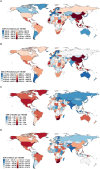
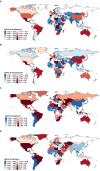
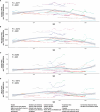
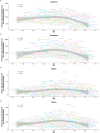
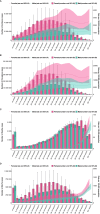


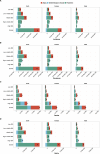
Similar articles
-
Global, regional, and national burden of maternal disorders, 1990-2021: a systematic analysis from the global burden of disease study 2021.BMC Public Health. 2025 Jul 29;25(1):2576. doi: 10.1186/s12889-025-23814-w. BMC Public Health. 2025. PMID: 40730990 Free PMC article.
-
Burden of knee osteoarthritis in China and globally: 1990-2045.BMC Musculoskelet Disord. 2025 Jul 1;26(1):582. doi: 10.1186/s12891-025-08858-8. BMC Musculoskelet Disord. 2025. PMID: 40598022 Free PMC article.
-
Global pattern, trend and cross-country inequalities of inguinal, femoral, and abdominal hernia among individuals aged 60 and above from 1990 to 2021 and projections until 2040: a population-based study.Surg Endosc. 2025 Jul;39(7):4335-4344. doi: 10.1007/s00464-025-11810-5. Epub 2025 May 28. Surg Endosc. 2025. PMID: 40437076
-
The global burden of fractures and its underlying etiologies: results from and further analysis of the Global Burden of Disease Study 2021.Arch Osteoporos. 2025 Aug 6;20(1):111. doi: 10.1007/s11657-025-01596-3. Arch Osteoporos. 2025. PMID: 40764873
-
Global burden and risk factors of musculoskeletal disorders among adolescents and young adults in 204 countries and territories, 1990-2019.Autoimmun Rev. 2023 Aug;22(8):103361. doi: 10.1016/j.autrev.2023.103361. Epub 2023 May 23. Autoimmun Rev. 2023. PMID: 37230312 Review.
References
-
- GBD 2021 Risk Factors Collaborators . Global burden of 87 risk factors in 204 countries and territories, 1990–2021: a systematic analysis for the Global Burden of Disease Study 2021. Lancet. (2022) 400:2224–60. doi: 10.1016/S0140-6736(22)01547-3 - DOI
-
- International Diabetes Federation . IDF Diabetes Atlas. 10th ed. Brussels, Belgium: International Diabetes Federation; (2021).
MeSH terms
LinkOut - more resources
Full Text Sources
Medical

